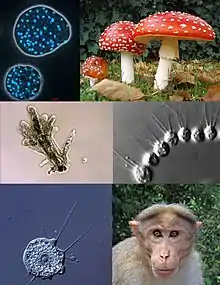Amorphea
Amorphea[3] are members of a taxonomic supergroup that includes the basal Amoebozoa and Obazoa. That latter contains the Opisthokonta, which includes the Fungi, Animals and the Choanomonada, or Choanoflagellates. The taxonomic affinities of the members of this clade were originally described and proposed by Thomas Cavalier-Smith in 2002.[1][4]
| Amorphea | |
|---|---|
 | |
| Clockwise, from top left: Abeoforma whisleri (Ichthyosporea); Amanita muscaria (Fungi); Desmarella moniliformis (Choanoflagellatea); Bonnet Macaque (Metazoa); Nuclearia thermophila (Nucleariida); Amoeba proteus (Amoebozoa) | |
| Scientific classification | |
| Domain: | Eukaryota |
| (unranked): | Unikonta Cavalier-Smith, 2002 |
| Subgroups | |
| Synonyms | |
The International Society of Protistologists, the recognised body for taxonomy of protozoa, recommended in 2012 that the term Unikont be changed to Amorphea because the name "Unikont" is based on a hypothesized synapomorphy that the ISP authors and other scientists later rejected.[3][5]
It includes amoebozoa, opisthokonts,[6][7] and possibly Apusozoa.[8]
Taxonomic revisions within this group
Cavalier-Smith has proposed two new phyla: Sulcozoa, which consists of the subphyla Apusozoa (Apusomonadida and Breviatea), and Varisulca, which includes the subphyla Diphyllatea, Discocelida, Mantamonadidae, Planomonadida and Rigifilida.[9] The validity of this proposed taxonomy has yet to be ruled upon by the Society of Protistologists.
Further work by Cavalier-Smith has shown that Sulcozoa is paraphyletic.[10] Apusozoa also appears to be paraphyletic. Varisulca has been redefined to include planomonads, Mantamonas and Collodictyon. A new taxon has been created - Glissodiscea - for the planomonads and Mantamonas. Again, the validity of this revised taxonomy awaits confirmation.
Amoebozoa seems to be monophyletic[11] with two major branches: Conosa and Lobosa. Conosa is divided into the aerobic infraphylum Semiconosia (Mycetozoa and Variosea) and secondarily anaerobic Archamoebae. Lobosa consists entirely of non-flagellated lobose amoebae and has been divided into two classes: Discosea, which have flattened cells, and Tubulinea, which has predominantly tube-shaped pseudopodia.
Clade
The group includes eukaryotic cells that, for the most part, have a single emergent flagellum, or are amoebae with no flagella. The unikonts include opisthokonts (animals, fungi, and related forms) and Amoebozoa. By contrast, other well-known eukaryotic groups, which more often have two emergent flagella (although there are many exceptions), are often referred to as bikonts. Bikonts include Archaeplastida (plants and relatives) and SAR supergroup, the Cryptista, Haptista, Telonemia and picozoa.
Characteristics
The unikonts have a triple-gene fusion that is lacking in the bikonts. The three genes that are fused together in the unikonts, but not bacteria or bikonts, encode enzymes for synthesis of the pyrimidine nucleotides: carbamoyl phosphate synthase, dihydroorotase, aspartate carbamoyltransferase. This must have involved a double fusion, a rare pair of events, supporting the shared ancestry of Opisthokonta and Amoebozoa.
Cavalier-Smith[1] originally proposed that unikonts ancestrally had a single flagellum and single basal body. This is unlikely, however, as flagellated opisthokonts, as well as some flagellated Amoebozoa, including Breviata, actually have two basal bodies, as in typical 'bikonts' (even though only one is flagellated in most unikonts). This paired arrangement can also be seen in the organization of centrioles in typical animal cells. In spite of the name of the group, the common ancestor of all 'unikonts' was probably a cell with two basal bodies.
References
- Cavalier-Smith T (March 2002). "The phagotrophic origin of eukaryotes and phylogenetic classification of Protozoa". Int. J. Syst. Evol. Microbiol. 52 (Pt 2): 297–354. doi:10.1099/00207713-52-2-297. PMID 11931142.
- Derelle, Romain; Torruella, Guifré; Klimeš, Vladimír; Brinkmann, Henner; Kim, Eunsoo; Vlček, Čestmír; Lang, B. Franz; Eliáš, Marek (17 February 2015). "Bacterial proteins pinpoint a single eukaryotic root". Proceedings of the National Academy of Sciences. 112 (7): E693–E699. doi:10.1073/pnas.1420657112. PMC 4343179. PMID 25646484.
- Adl SM, Simpson AG, Lane CE, Lukeš J, Bass D, Bowser SS, Brown MW, Burki F, Dunthorn M, Hampl V, Heiss A, Hoppenrath M, Lara E, Le Gall L, Lynn DH, McManus H, Mitchell EA, Mozley-Stanridge SE, Parfrey LW, Pawlowski J, Rueckert S, Shadwick RS, Schoch CL, Smirnov A, Spiegel FW (September 2012). "The revised classification of eukaryotes". J Eukaryot Microbiol. 59 (5): 429–93. doi:10.1111/j.1550-7408.2012.00644.x. PMC 3483872. PMID 23020233.
- Cavalier-Smith, Thomas (2003). "Protist phylogeny and the high-level classification of Protozoa". European Journal of Protistology. 39 (4): 338–348. doi:10.1078/0932-4739-00002.
- Roger AJ, Simpson AG (2009). "Evolution: revisiting the root of the eukaryote tree". Current Biology. 19 (4): R165–R167. doi:10.1016/j.cub.2008.12.032. PMID 19243692.
- A Minge M, Silberman JD, Orr RJ, et al. (November 2008). "Evolutionary position of breviate amoebae and the primary eukaryote divergence". Proc. Biol. Sci. 276 (1657): 597–604. doi:10.1098/rspb.2008.1358. PMC 2660946. PMID 19004754.
- Burki F, Pawlowski J (October 2006). "Monophyly of Rhizaria and multigene phylogeny of unicellular bikonts". Mol. Biol. Evol. 23 (10): 1922–30. doi:10.1093/molbev/msl055. PMID 16829542.
- Glücksman E, Snell EA, Berney C, Chao EE, Bass D, Cavalier-Smith T (September 2010). "The Novel Marine Gliding Zooflagellate Genus Mantamonas (Mantamonadida ord. n.: Apusozoa)". Protist. 162 (2): 207–221. doi:10.1016/j.protis.2010.06.004. PMID 20884290.
- Cavalier-Smith T (May 2013). "Early evolution of eukaryote feeding modes, cell structural diversity, and classification of the protozoan phyla Loukozoa, Sulcozoa, and Choanozoa". Eur J Protistol. 49 (2): 115–78. doi:10.1016/j.ejop.2012.06.001. PMID 23085100.
- Cavalier-Smith T, Chao EE, Snell EA, Berney C, Fiore-Donno AM, Lewis R (December 2014). "Multigene eukaryote phylogeny reveals the likely protozoan ancestors of opisthokonts (animals, fungi, choanozoans) and Amoebozoa". Mol Phylogenet Evol. 81: 71–85. doi:10.1016/j.ympev.2014.08.012. PMID 25152275.
- Cavalier-Smith T, Fiore-Donno AM, Chao E, Kudryavtsev A, Berney C, Snell EA, Lewis R (February 2015). "Multigene phylogeny resolves deep branching of Amoebozoa". Mol Phylogenet Evol. 83: 293–304. doi:10.1016/j.ympev.2014.08.011. PMID 25150787.
- Phylogeny based on:
- Eichinger, L.; Pachebat, J. A.; Glöckner, G.; Rajandream, M. A.; Sucgang, R.; Berriman, M.; Song, J.; Olsen, R.; et al. (2005). "The genome of the social amoeba Dictyostelium discoideum". Nature. 435 (7038): 43–57. doi:10.1038/nature03481. PMC 1352341. PMID 15875012.
- Steenkamp, E. T.; Wright, J.; Baldauf, S. L. (2005). "The Protistan Origins of Animals and Fungi". Molecular Biology and Evolution. 23 (1): 93–106. doi:10.1093/molbev/msj011. PMID 16151185.
External links
| Wikispecies has information related to Unikonta. |
| Wikimedia Commons has media related to Unikonta. |
- "Eukaryotes". Tree of Life.org
